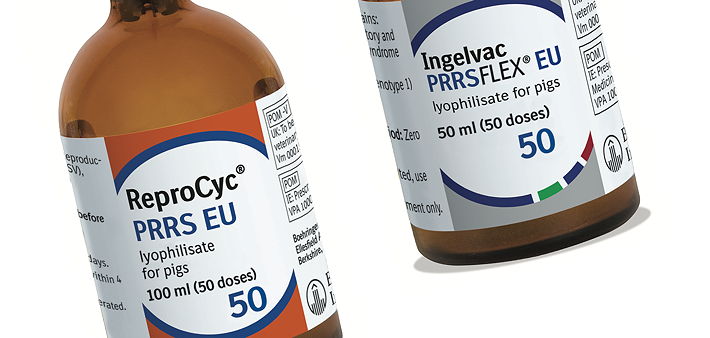Porcine reproductive and respiratory syndrome (PRRS) may have been around for 25 years, but it remains a costly disease to the global pig industry.
The annual impact in Europe is estimated at £1.1 billion – with the finisher herd bearing 54% of that cost and the breeding herd the remaining 46%. The costs in individual countries range from £75 to £150/sow/year.
A recent survey of UK vets estimated the prevalence of PRRS here at 52% of sows and 47% of piglets, and the ongoing cost of chronic PRRS infection in a herd here is put at about £107/sow/year.
Boehringer Ingelheim has 20 years of experience in the US and some European countries with a PRRS vaccine based on a North American (genotype 2) strain, but has now introduced two new vaccines aimed at protecting against the effects of European (genotype 1) strains. The first is Ingelvac PRRSFLEX EU, which is the only PRRS vaccine licensed specifically for piglets available to UK producers.
For active immunisation of clinically healthy pigs from farms affected with PRRS, a 1ml intramuscular dose can be given to piglets from 17 days of age. The onset of immunity is three weeks, and the duration of immunity is 26 weeks.
An experimental challenge of seronegative animals demonstrated that vaccination reduced lung lesions, the virus load in the blood and lung tissues, and the negative effects of infection on daily weight gain. A significant reduction of the respiratory clinical signs has also been demonstrated at the onset of immunity.
Sow vaccine
ReproCyc PRRS EU, meanwhile, is for breeding gilts and sows in herds affected with European strains of PRRS, and can be administered at all stages of the reproductive cycle as part of a mass-vaccination programme. Each dose, which unlike the piglet vaccine includes an adjuvant, is 2ml given intramuscularly. The onset of immunity is five weeks and the duration of immunity is 17 weeks – so the treatment is recommended to be repeated every three months as a mass vaccination.
Treatment of breeding females reduces PRRS-induced reproductive disorders such as premature farrowing, weak-born piglets and neonatal mortality. Vaccinated gilts and sows also show decreased transplacental PRRS virus transmission from infected females to piglets and a reduction in the negative effects of PRRS virus infection on their piglets during suckling.
Pre-launch registration trials of ReproCyc PRRS EU have shown mortality 3.2% lower in piglets born to vaccinated sows and average weaning weights 610g higher than piglets from non-vaccinated sows.
“We’re very confident that the simultaneous launch of these two new vaccines will significantly benefit UK pig producers,” Boehringer Ingelheim’s UK swine business manager, Dr David Strachan, said. “The company has worked hard to develop an effective solution for sustainable whole-herd PRRS control, and we’re convinced that these two new vaccines are a great combination.”
PRRS control
Along with the new vaccines, Boehringer Ingelheim has introduced a systematic approach to PRRS control that’s based on the three pillars of: preventing infection by using good biosecurity to stop the introduction of new virus; maximising immunity throughout the whole herd; and minimising exposure of pigs to PRRS by reducing circulation of the farm’s resident virus through a tailored control programme.
The company’s PRRS 5-Step Process is a systematic platform that allows vets and producers to co-ordinate and optimise the use of multiple management tools to make PRRS control simpler and more effective:
Step 1 is to identify desired goals. These may vary significantly from unit to unit, but will ultimately be focused on either controlling PRRS or even eliminating it (this has been done in herds affected by genotype 2 strains, and Boehringer Ingelheim is confident similar results can be achieved against genotype 1).
Step 2 then involves determining current PRRS status, which is done by evaluating PRRSv shedding and PRRSv exposure. Classification of herds based on PRRS status helps to identify objectives for controlling and/or eliminating the virus.
Step 3 is aimed at understanding any constraints that exist, as designing a vaccination and control programme requires objective assessment of the capabilities and limitations of the production system. Typical constraints could be a shortage of labour, the presence of other diseases or biosecurity issues on the unit.
Step 4 sees the producer and vet working together to develop solution options.
Step 5 is the implementation and monitoring of the preferred solution. Ongoing monitoring of production parameters, clinical signs and diagnostic information will ultimately reveal the success of the programme.




